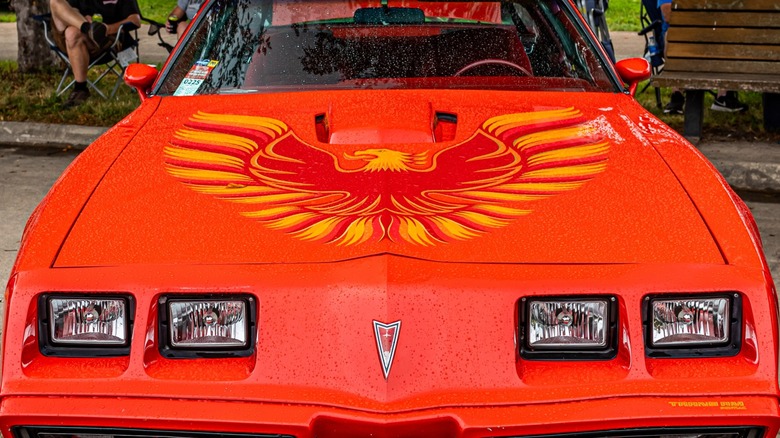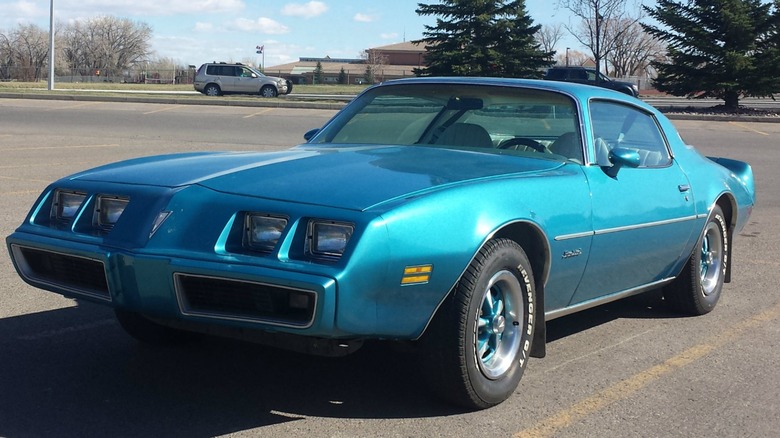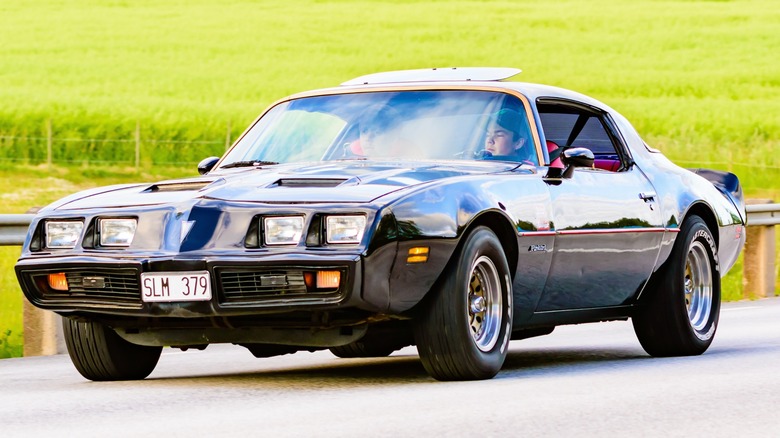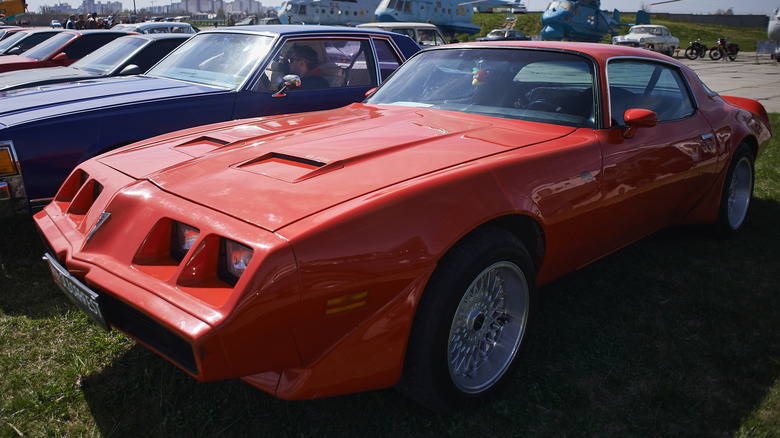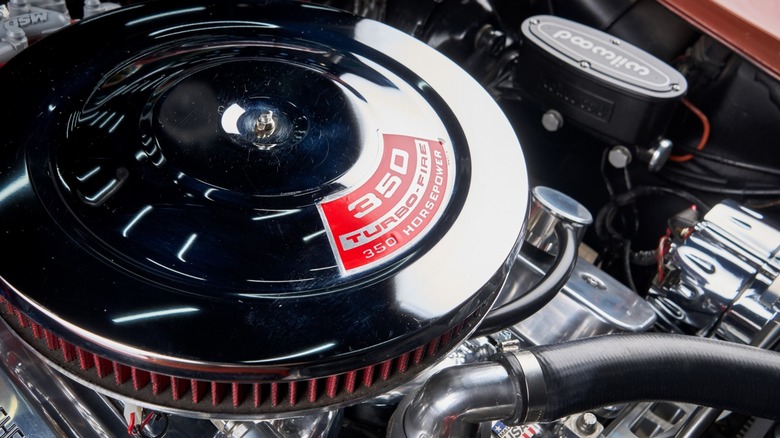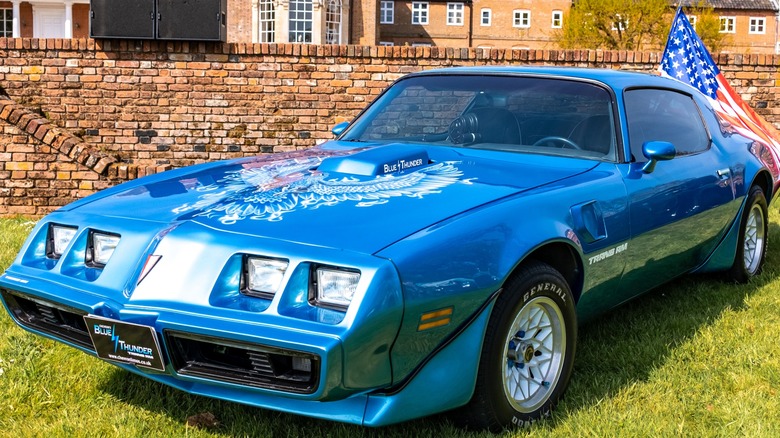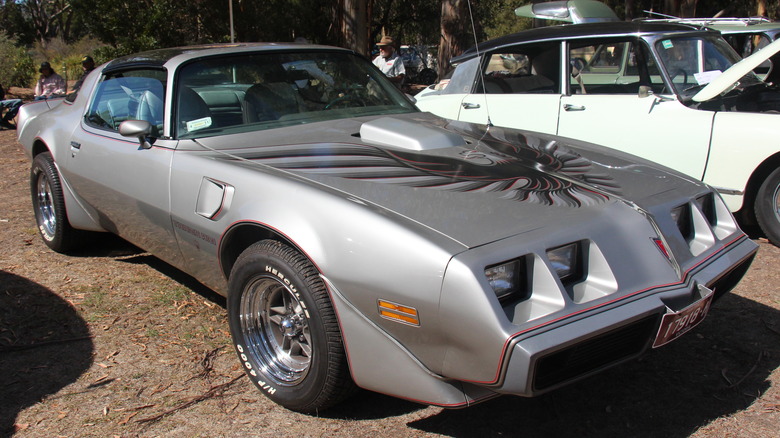All About The Engines That Powered The 1979 Pontiac Firebird
The second-generation Pontiac Firebird, with appearances as Jim Rockford's trusty steed in "The Rockford Files" and an iconic movie role in both "Smokey and the Bandit" and its sequel, became one of the most popular of all the Firebird generations and lasted from 1970 to 1981. It's interesting, however, that Rockford drove a lower-trimmed Firebird, while a Trans Am roared across the silver screen with Burt Reynolds at the wheel as the Bandit.
A great example of Gen-II Pontiac Firebird styling is the 1979 model year which was available in several hardtop coupe models, such as the base Firebird, Esprit, Formula, Trans Am, and 10th Anniversary Trans Am. The 1979 Pontiac Firebird models below the Trans Am were primarily powered by V8 engines, although in some rare instances you could find a V6 under the hood, while the Firebird Trans Am offered a choice of three V8 power plants, two of which would not return for the 1980 model year.
Buick 3800 V6
While it's difficult to find production numbers for V6-powered 1979 Pontiac Firebirds, evidence of their existence pops up from time to time. If you find a second-generation Firebird with a V6 engine under the hood, it's most likely the 3.8-liter, or 3800 Buick variety.
Hagerty says the Buick 3800 V6, produced from 1975 to 2008, holds a significant place in GM engine history alongside the small-block Chevrolet V8. While on the surface that statement appears borderline blasphemous, the 3.8-liter Buick V6 powered more than 25 million GM cars, including the Pontiac Firebird.
Buick's decision to add turbocharged induction to the 3.8-liter V6 enforces its bid for a spot in the GM engine hall of fame. In their day, the turbocharged V6 Buick Regal Grand National and Buick GNX were among the most formidable factory street cars on the market, even compared to V8-powered Chevrolet Corvettes and Ford Mustang GTs.
[Featured image by dave_7 via Wikimedia Commons | Cropped and scaled | CC BY-SA 2.0]
Pontiac 301-cubic inch V8
A more common sight when popping the hood of a 1979 Pontiac Firebird, especially in the base, Esprit, and Formula models — although it was optional in the Trans Am — is the 301-cubic inch V8 from Pontiac. The Pontiac 301 came with options for a two-barrel carburetor delivering 135 horsepower or a four-barrel with 150 horsepower.
According to Hemmings, the Pontiac 301 was designated as an economy engine when it was introduced in 1977 and, when chosen as an option for the 1979 Pontiac Firebird Trans Am, lowered the price by $195. However, even with its economy status it was unavailable for sale in California. Trans Am models fitted with the four-barrel 301, or 4.9-liter V8, are designated with a W in the VIN code and "T/A 4.9" emblazoned on the Shaker scoop sticking through the hood.
Manual shift- and automatic transmission-equipped Pontiac Firebirds received different spec camshafts in the 4.9-liter V8. While both types had 0.374 inches of lift, manual shift cams had 274 degrees of duration with a 59-degree overlap, and automatics got a 250-degree duration camshaft with 38 degrees of overlap.
Chevrolet 305-cubic inch V8
Another relatively rare find under the hood of some lower-model 1979 Pontiac Firebirds is the 305-cubic inch V8 from Chevrolet. Chevrolet produced the LG3 version of its 305 from 1976 to 1980, and while it served as the power plant for late 1970s Chevy Camaros and Novas, it was occasionally called into duty for the Pontiac Firebird.
In its most potent form, the Chevrolet 305 LG3 could produce up to 160 horsepower and 250 lb-ft of torque. However, the LG3 found in a 1979 Pontiac Firebird had a two-barrel carburetor and a low-octane-friendly 8.5:1 compression ratio good for only 145 horsepower.
The following year saw the introduction of the four-barrel carburetor LG4 that bumped horsepower to a maximum of 170 with the same torque rating of 250 lb-ft that would remain in service until 1987. The highest output from a Chevy 305 comes from the L69 variant. The L69 305 delivers up to 190 horsepower and 240 ft-lb of torque thanks primarily to the higher 9.5:1 compression ratio.
Chevy 350-cubic inch 5.7-liter V8
Another 1979 Pontiac Firebird engine option that was available in some parts of the country was the 350-cubic inch 5.7-liter small-block Chevy V8. First introduced as a power plant for the new 1967 Camaro with 295 horsepower and 380 lb-ft of torque, the 350 Chevy has powered every GM performance car and many full-size cars and pickup trucks, providing a wide range of power outputs before being discontinued after 2002.
The first-generation small-block 350 Chevy hit its peak production horsepower in 1970 with the LT-1, making 370 horsepower in the Corvette ZR-1 and Camaro Z28. Unfortunately, emissions controls and low-octane gasoline lowered the output of the 350 powering a 1979 Firebird to around 170 horsepower. At least that's an improvement over the 350's lowest horsepower rating of 145.
If you have an original 350 small-block-powered 1979 Firebird that's missing an engine, it will prove difficult to find a matching equivalent from another Firebird. The good news is that 350 Chevy engines are plentiful and Chevrolet still sells a High-Output 350 Crate Engine through its performance parts catalog online.
Oldsmobile 403-cubic inch V8
One of the most common engines found in the 1979 Pontiac Firebird is the 403-cubic inch Oldsmobile V8. The 403 Olds was an option for most of the 1979 Firebird lineup and standard issue for the Trans Am and known as one of the best Oldsmobile engines ever produced.
The L80 Olds 403-cubic inch small-block used in the 1979 Pontiac Firebird Trans Am produced 185 horsepower and a respectable 320 lb-ft of torque. The Olds 403 has 4.351-inch diameter cylinders and a crankshaft providing 3.385 inches of stroke. While the large cylinders and short stroke deliver good torque numbers, its 83cc combustion chambers results in an 8.1:1 compression ratio that reduces its horsepower output.
With the 1970s being recognized as less than friendly to high-output engines, it's no surprise that there is considerably more horsepower lurking under the 403's valve covers as reported by MotorTrend. However, while a common sight under 1979 Firebird hoods, the Olds 403 is comparatively rare given that it was only produced from 1977 through 1979.
Pontiac 400-cubic inch 6.6-liter V8
The premier engine option for the 1979 Pontiac Firebird was Pontiac's own 400-cubic inch V8, also known as the 6.6-liter. However, Pontiac 6.6 production was discontinued following the 1978 model year. Thankfully, some wise folks at Pontiac saw the writing on the wall and stockpiled thousands of Pontiac 400 engine blocks for use the following year. The 1979 400 engine option came in two flavors: L78 and W72.
The L78 Pontiac 400, available as an option across the 1979 Pontiac Firebird lineup, delivered 180 horsepower. Although the L78 featured a four-barrel carburetor, its low 7.6:1 compression ratio used it to little benefit.
The W72 version of the 6.6, which was only an option for the '79 Trans Ams, came out a couple of years before. Early versions increased the engine's power from 180 to 200 horsepower using a "specific Rochester Quadrajet carburetor and HEI distributor," according to MotorTrend. Of course, slapping a better carburetor and distributor onto an L78 isn't enough to achieve the 1978-1979 T/A 6.6's 220 horsepower. That increase required a higher compression ratio, a new camshaft design, and a higher flowing exhaust system.
[Featured image by Sicnag via Wikimedia Commons | Cropped and scaled | CC BY-SA 2.0]
